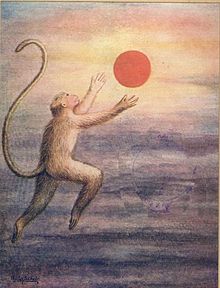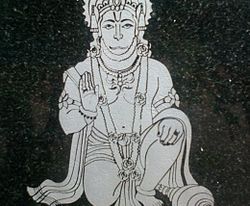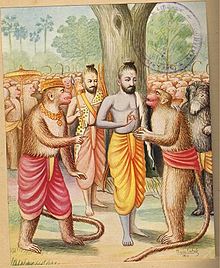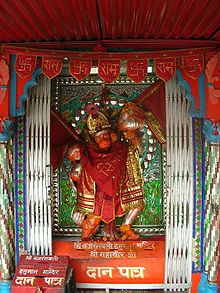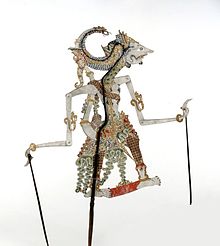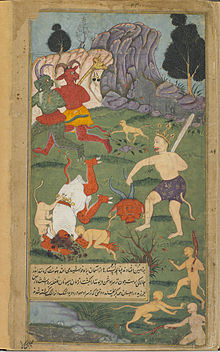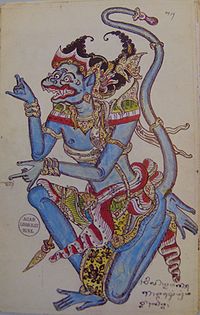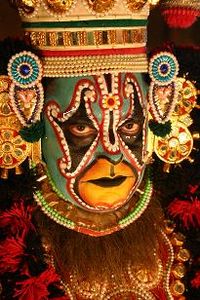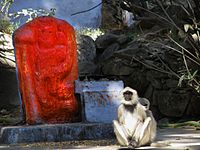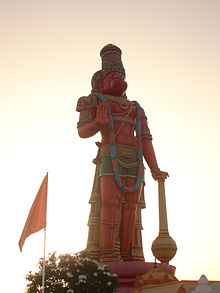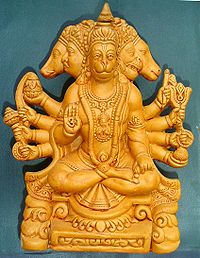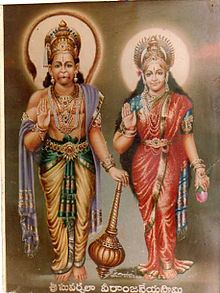- Hanuman
-
"Bajrangbali" redirects here. For the movie, see Bajrangbali (film).
Hanuman 
Depiction of Hanuman
Chola Dynasty, 11th CenturySanskrit Transliteration हनुमान् Affiliation Devotee of Rama, Avatar of Shiva, Vanara Mantra Hanuman Chalisa Weapon Gada (Mace) Hanuman (Sanskrit: हनुमान्, Hanumān), is a Hindu deity, who is an ardent devotee of Rama, a central character in the Indian epic Ramayana and one of the dearest devotees of lord Rama. A general among the vanaras, an ape-like race of forest-dwellers, Hanuman is an incarnation of the divine and a disciple of Lord Rama in the struggle against the demon king Ravana. Also known as Anjaneya, Maruti, Pavanputra, Kesharinandan, Arbiter, Anjaniputra, Bajrang Bali and Hanumat, Hanuman's exploits are much celebrated in a variety of religious and cultural traditions,[1] particularly in Hinduism, so much so that he is often the object of worship according to some bhakti traditions,[2] and is the prime deity in many temples known as Hanuman Mandirs.
Birth
Hanuman was born to Anjana, a female vanara, and Kesari, a male vanara, in Anjana Giri mountain. His mother was an apsara who was born on Earth as a female vanara due to a curse. She would be redeemed from this curse on her giving birth to an incarnation of Lord Shiva, who is also known as Rudra, and endowed with the Supreme Power of exalted devotion to Bhagwan Hari. Hanuman is endowed with 28 transcendental divine opulences, with perfection in each.
Multiple places in India are claimed as the birth place of Hanuman. Even Trimbakeshwar, Anjan, a small village about 18 km away from Gumla, houses "Anjan Dham", which is said to be the birth place of Hanuman.[3] The name of the village is derived from the name of the goddess Anjani, mother of Mahaveer Hanuman. Aanjani Gufa (cave), 4 km from the village, is believed to be the place where Anjani once lived. Many objects of archaeological importance obtained from this site are now held at the Patna Museum. Its a popular belief that Hanuman was born on 'Anjaneya Hill', in Hampi, Karnataka.[4] This is located near the Risyamukha mountain on the banks of the Pampa, where Sugreeva and Sri Rama are said to have met in Valmiki Ramayana's Kishkinda Kanda. There is a temple that marks the spot. Anjaneri (or Anjneri) mountain, located 7 km from Trimbakeshwar in the Nashik district, is also claimed as the birthplace of Hanuman.[5]
Anjana, along with her husband Kesari, performed intense prayers to Lord Shiva to beget Him as her Child. Pleased with their devotion, Shiva granted them the boon they sought.[6] Hence, Hanuman is also known as "Maharudra" because he was born of the boon given to Anjana by Shiva. The Valmiki Ramayana states that Kesari is the son of Brihaspati and that Kesari also fought on Rama's side in the war against Ravana.
Several different traditions account for Hanuman's birth. One is that at the time that Anjana was worshipping Lord Shiva, elsewhere, Dasharatha, the king of Ayodhya, was performing the Putrakama Yagna in order to have children. As a result, he received some sacred pudding, payasam, to be shared by his three wives, leading to the births of Rama, Lakshmana, Bharata, and Shatrughna. By divine ordinance, a kite snatched a fragment of that pudding and dropped it while flying over the forest where Anjana was engaged in worship. Vayu, the Hindu deity of the wind, delivered the falling pudding to the outstretched hands of Anjana, who consumed it. Hanuman was born to her as a result.[7]
Hanuman, in one interpretation, is the incarnation or reflection of Shiva. Other interpretations, such as that of Dvaita, consider Hanuman to be the son of, or a manifestation of, Vayu, god of wind. When Ravana tried to enter the abode of Shiva, he called Nandishwara "a monkey". Nandishwara in turn cursed Ravana, that a monkey would burn his Lanka.
Another story of Hanuman's origins is derived from the Vishnu Purana and Naradeya Purana. Narada, infatuated with a princess, went to his God Lord Vishnu, to make him look like Sri Vishnu, so that the princess would garland him at Swayamvara. He asked for a Hari-Mukh. Hari is the name of Lord Vishnu and Mukh means face. But Vishnu instead bestowed him with the face of a monkey. Unaware of this, Narada went to the princess, who burst into laughter at the sight of his monkey face before all the king's court. Narada, unable to bear the humiliation, cursed Vishnu, that Vishnu would one day be dependent upon a vanara. Vishnu replied that what he had done was for Narada's own good, as he would have undermined his own powers if he were to enter matrimony. Vishnu also noted that Narada's request for Hari has the dual Sanskrit meaning of vanara. Upon hearing this, Narada repented for cursing his idol. But Vishnu told him not repent as the curse would act as a boon, for it would lead to the birth of Hanuman, without whose help Rama (Vishnu's avatar) could not kill Ravana.
References to Hanuman in classical literature could be found as early as those of 5th to 1st century BC in Panini's Astadhyayi, Abhiseka Nataka, Pratima Nataka, and Kālidāsa's Raghuvaṃśa.
Childhood, education, boons and curse
As a child, believing the sun to be a ripe mango, Hanuman pursued it in order to eat it. Rahu, a Vedic planet corresponding to an eclipse, was at that time seeking out the sun as well, and he clashed with Hanuman. In the nature of Rahu, the Tamas Guṇa predominated. To convey a message to the universe that Satva Guṇa always prevails, Hanuman thrashed Rahu and goes to take sun in his abode.[8] Indra, king of devas, was approached by defeated Rahu with disappointment, complaining that a monkey child stopped him from taking on Sun, as is permitted by you so that Solar eclipse could not take place. This enraged Indra, who responded by throwing the Vajra (thunderbolt) at Hanuman, which struck his jaw. He fell back down to the earth and became unconscious. Upset, Vayu went into seclusion, taking the atmosphere with him. As living beings began to asphyxiate, Indra withdrew the effect of his thunderbolt, and the devas revived Hanuman and blessed him with multiple boons. Brahma then gave Hanuman a boon that would protect him from the proverbial irrevocable curse called Brahma’s curse - Brahmashap. Brahmadev also said: "Nobody will be able to kill you with any weapon in war." From Brahma he obtained the power of inducing fear in enemies, of destroying fear in friends, to be able to change his form at will and to be able to easily travel wherever he wished. From Mahadevji he obtained the boons of longevity, scriptural wisdom and ability to cross the ocean. Lord Shiva assured safety of Hanuman with a band (kavach) that would protect him for life Indra blessed him that his weapon Vajra, will no longer be effective on him and his body would become stronger than Vajra. Varuna blessed baby Hanuman with a boon that he would always be protected from water. Agni blessed him, Saying, "Fire will never burn you." Surya gave him two siddhis of yoga namely "laghima" and "garima". With "laghima" he could attain the smallest form and with "garima" he could attain the biggest form of life. Vayu blessed him with more speed than he himself had. Yama, the God of Death blessed him healthy life and free from his weapon Yama Danda, thus death would not come to him. Kubera showered his blessings declaring that Hanuman would always remain happy and contented. Vishwakarma blessed him that Hanuman would be protected from all his creations in the form of objects or weapons[9][10][11][12] A permanent mark was left on his chin (हनुः hanuḥ "jaw" in Sanskrit), due to impact of Vajra, explaining his name.
On ascertaining Surya, the Hindu deity of the sun, to be an all-knowing teacher, Hanuman raised his body into an orbit around the sun and requested that Surya accept him as a student. Surya refused, claiming that as he always had to be on the move in his chariot, it would be impossible for Hanuman to learn effectively. Undeterred by Surya's refusal, Hanuman enlarged his body, placed one leg on the eastern ranges and the other on the western ranges, and with his face turned toward the sun made his request again. Pleased by his persistence, Surya accepted. Hanuman then moved (backwards, to remain facing Surya) continuously with his teacher, and learned all of the latter's knowledge. When Hanuman then requested Surya to quote his "guru-dakshina" (teacher's fee), the latter refused, saying that the pleasure of teaching one as dedicated as him was the fee in itself. Hanuman insisted, whereupon Surya asked him to help his (Surya's) spiritual son Sugriva.[13] Hanuman's choice of Surya as his teacher is said to signify Surya as a Karma Saakshi, an eternal witness of all deeds. Hanuman was mischievous in his childhood, and sometimes teased the meditating sages in the forests by snatching their personal belongings and by disturbing their well-arranged articles of worship. Finding his antics unbearable, but realizing that Hanuman was but a child, (albeit invincible), the sages placed a mild curse on him by which he became unable to remember his own ability unless reminded by another person. It is hypothesised that without this curse, the entire course of the Ramayana war might have been different, for he demonstrated phenomenal abilities during the war. The curse is highlighted in Kishkindha Kanda and Sundara Kanda when Jambavantha reminds (the quietly wondering) Hanuman of his abilities and encourages him to go and find Sita. The specific verse that is recited by Jambavantha is:
- : आप के रूप में हवा के रूप में में शक्तिशाली कर रहे हैं
- : आप बुद्धिमान, शानदार, और एक आविष्कारक हैं.
- : वहाँ इस दुनिया में कुछ भी नहीं है कि आप के लिए बहुत बहुत मुश्किल है है
- : जब भी अटक गया, तो आप एक है जो मदद कर सकते हैं
You are as powerful as the wind (Hanumanji was the son of Pawan, God of wind);
You are intelligent, illustrious & an inventor.
There is nothing in this world that’s too difficult for you;
Whenever stuck, you are the one who can help.
In the Ramayana
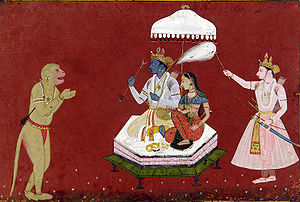 A 17th century painting depicting Hanuman worshiping Lord Rama and his wife Sita. Lakshmana is also seen in this painting from Smithsonian Institution collection.
A 17th century painting depicting Hanuman worshiping Lord Rama and his wife Sita. Lakshmana is also seen in this painting from Smithsonian Institution collection.
The Sundara Kanda, the fifth book in the Ramayana, focuses on the adventures of Hanuman.
Meeting Rama
Hanuman meets Rama during the latter's 14-year exile in the forest.[14] With his brother Lakshmana, Rama is searching for his wife Sita who had been abducted by Ravana. Their search brings them to the vicinity of the mountain Rishyamukha, where Sugriva, along with his followers and friends, are in hiding from his older brother Vali, with whom he had quarrelled over a mistake.
Having seen Rama and Lakshmana, Sugriva sends Hanuman to ascertain their identities. Hanuman approaches the two brothers in the guise of a brahmin. His first words to them are such that Rama says to Lakshmana that none could speak the way the brahmin did unless he or she had mastered the Vedas. He notes that there is no defect in the brahmin's countenance, eyes, forehead, brows, or any limb. He points out to Lakshmana that his accent is captivating, adding that even an enemy with sword drawn would be moved. He praises the disguised Hanuman further, saying that sure success awaited the king whose emissaries were as accomplished as he was.[14]
When Rama introduces himself, Hanuman reveals his own identity and falls prostrate before Rama, who embraces him warmly. Thereafter, Hanuman's life becomes interwoven with that of Rama. Hanuman then brings about a friendship and alliance between Rama and Sugriva; Rama helps Sugriva regain his honour and makes him king of Kishkindha. Sugriva and his vanaras, most notably Hanuman, help Rama defeat Ravana and reunite with Sita.
In their search for Sita, a group of Vanaras reaches the southern seashore. Upon encountering the vast ocean, every vanara begins to lament his inability to jump across the water. Hanuman too is saddened at the possible failure of his mission, until the other vanaras and the wise bear Jambavantha begin to extol his virtues. Hanuman then recollects his own powers, enlarges his body, and flies across the ocean. On his way, he encounters a mountain that rises from the sea, proclaims that it owed his father a debt, and asks him to rest a while before proceeding. Not wanting to waste any time, Hanuman thanks the mountain and carries on. He then encounters a sea-monster, Surasa, who challenges him to enter her mouth. When Hanuman outwits her, she admits that her challenge was merely a test of his courage. After killing Simhika, a rakshasa, he reaches Lanka.
Locating Sita
Hanuman reaches Lanka and marvels at its beauty. After he finds Sita in captivity in a garden, Hanuman reveals his identity to her, reassures her that Rama has been looking for her, and uplifts her spirits. He offers to carry her back to Rama, but she refuses his offer, saying it would be an insult to Rama as his honour is at stake. After meeting Sita, Hanuman begins to wreak havoc, gradually destroying the palaces and properties of Lanka. He kills many rakshasas, including Jambumali and Aksha Kumar. To subdue him, Ravana's son Indrajit uses the Brahmastra. Though immune to the effects of this weapon Hanuman, out of respect to Brahma, allows himself be bound. Deciding to use the opportunity to meet Ravana, and to assess the strength of Ravana's hordes, Hanuman allows the rakshasa warriors to parade him through the streets. He conveys Rama's message of warning and demands the safe return of Sita. He also informs Ravana that Rama would be willing to forgive him if he returns Sita honourably.
Enraged, Ravana orders Hanuman's execution, whereupon Ravana's brother Vibhishana intervenes, pointing out that it is against the rules of engagement to kill a messenger. Ravana then orders Hanuman's tail be lit afire. As Ravana's forces attempted to wrap cloth around his tail, Hanuman begins to lengthen it. After frustrating them for a while, he allows it to burn, then escapes from his captors, and with his tail on fire he burns down large parts of Lanka. After extinguishing his flaming tail in the sea, he returns to Rama.[15]
Shapeshifting
In the Ramayana Hanuman changes shape several times. For example, while he searches for the kidnapped Sita in Ravana's palaces on Lanka, he contracts himself to the size of a cat, so that he will not be detected by the enemy. Later on, he takes on the size of a mountain, blazing with radiance, to show his true power to Sita.[16]
Also he enlarges & immediately afterwards contracts his body to out-wit Sirsa, the she-demon, who blocked his path while crossing sea to reach Lanka. Again, he turns his body micro to enter Lanka before killing Lankini, the she-demon guarding gates of Lanka.
He achieved this shape-shifting by the powers of two siddhis; Anima and Garima bestowed upon him in his childhood by Sun-God, Surya.
Lifting a mountain
When Lakshmana is severely wounded during the battle against Ravana, Hanuman is sent to fetch the Sanjivani, a powerful life-restoring herb, from Dronagiri mountain in the Himalayas, to revive him. Ravana realises that if Lakshmana dies, a distraught Rama would probably give up, and so he dispatches the sorcerer Kalanemi to intercept Hanuman.[17] Kalanemi, in the guise of a sage, deceives Hanuman, but Hanuman uncovers his plot with the help of an apsara, whom he rescues from her accursed state as a crocodile.[17]
Ravana, upon learning that Kalanemi has been slain by Hanuman, summons Surya to rise before its appointed time because the physician Sushena had said that Lakshmana would perish if untreated by daybreak. Hanuman realizes the danger, however, and, becoming many times his normal size, detains the Sun God to prevent the break of day. He then resumes his search for the precious herb, but, when he finds himself unable to identify which herb it is, he lifts the entire mountain and delivers it to the battlefield in Lanka. Sushena then identifies and administers the herb, and Lakshmana is saved. Rama embraces Hanuman, declaring him as dear to him as his own brother. Hanuman releases Surya from his grip, and asks forgiveness, as the Sun was also his Guru.
Hanuman was also called "langra veer"; langra in Hindi means lame and veer means "bravest of brave". The story behind Hanuman being called langra is as follows. He was injured when he was crossing the Ayodhya with the mountain in his hands. As he was crossing over Ayodhya, Bharat, Rama's young brother, saw him and assumed that some Rakshasa was taking this mountain to attack Ayodhya. Bharat then shot Hanuman with an arrow, which was engraved with Rama's name. Hanuman did not stop this arrow as it had Rama's name written on it, and it injured his leg. Hanuman landed and explained to Bharat that he was moving the mountain to save his own brother, Lakshmana. Bharat, very sorry, offered to fire an arrow to Lanka, which Hanuman could ride in order to reach his destination more easily. But Hanuman declined the offer, preferring to fly on his own, and he continued his journey with his injured leg.
Patala incident
In another incident during the war, Rama and Lakshmana are captured by the rakshasa Mahiravana (or Ahiravan), brother of Ravana, who held them captive in their palace in Patala (or Patalpuri)--the netherworld. Mahiravana keeps them as offerings to his deity. Searching for them, Hanuman reaches Patala, the gates of which are guarded by a young creature called Makardhwaja (known also as Makar-Dhwaja or Magar Dhwaja), who is part reptile and part Vanara.
The story of Makardhwaja's birth is said to be that when Hanuman extinguished his burning tail in the ocean, a drop of his sweat fell into the waters, eventually becoming Makardhwaja, who perceives Hanuman as his father. When Hanuman introduces himself to Makardhwaja, the latter asks his blessings, but fights him to fulfill the task of guarding the gate. Hanuman defeats and imprisons him to gain entry.
Upon entering Patala, Hanuman discovers that to kill Mahiravana, he must simultaneously extinguish five lamps burning in different directions. Hanuman assumes the Panchamukha or five-faced form of Sri Varaha facing north, Sri Narasimha facing south, Sri Garuda facing west, Sri Hayagriva facing the sky and his own facing the east, and blows out the lamps. Hanuman then rescues Rama and Lakshmana. Afterwards, Rama asks Hanuman to crown Makardhwaja king of Patala. Hanuman then instructs Makardhwaja to rule Patala with justice and wisdom.
To date Panchamukha Anjaneya mandir is located at Panchmukhi a small village 20 km from Mantralayam, Kurnool district, Andhra Pradesh. A divine place where Sri Guru Raghavendra Swamy rests.
Bharata's vow
When the war ends, Rama's 14-year exile has almost elapsed. Rama then remembers Bharata's vow to immolate himself if Rama does not return to rule Ayodhya immediately, on completion of the stipulated period. Realising that it would be a little later than the last day of the 14 years when he would reach Ayodhya, Rama is anxious to prevent Bharata from giving up his life. Hanuman therefore flies to Ayodhya to inform Bharata that Rama is on his way home.
Honours
Shortly after he is crowned Emperor upon his return to Ayodhya, Rama decides to ceremoniously reward all his well-wishers. At a grand ceremony in his court, all his friends and allies take turns being honoured at the throne. Hanuman approaches without desiring a reward. Seeing Hanuman come up to him, an emotionally overwhelmed Rama embraces him warmly, declaring that he could never adequately honour or repay Hanuman for the help and services he received from the noble Vanara. Sita, however, insists that Hanuman deserved honour more than anyone else, and Sita gives him a necklace of precious stones adorning her neck.
When he receives it, Hanuman immediately takes it apart, and peers into each stone. Taken aback, many of those present demand to know why he is destroying the precious gift. Hanuman answers that he was looking into the stones to make sure that Rama and Sita are in them, because if they are not, the necklace is of no value to him. At this, a few mock Hanuman, saying his reverence and love for Rama and Sita could not possibly be as deep as he implies. In response, Hanuman tears his chest open, and everyone is stunned to see Rama and Sita literally in his heart.
Hanuman Ramayana
After the victory of Rama over Ravana, Hanuman went to the Himalayas to continue his worship of the Lord. There he scripted a version of the Ramayana on the Himalayan mountains using his nails, recording every detail of Rama's deeds. When Maharishi Valmiki visited him to show him his own version of the Ramayana, he saw Hanuman's version and became very disappointed.
When Hanuman asked Valmiki the cause of his sorrow, the sage said that his version, which he had created very laboriously, was no match for the splendour of Hanuman's, and would therefore go ignored. At this, Hanuman discarded his own version, which is called the Hanumad Ramayana. Maharishi Valmiki was so taken aback that he said he would take another birth to sing the glory of Hanuman which he had understated in his version.
Later, one tablet is said to have floated ashore during the period of Mahakavi Kalidasa, and hung at a public place to be deciphered by scholars. Kalidasa is said to have deciphered it and recognised that it was from the Hanumad Ramayana recorded by Hanuman in an extinct script, and considered himself very fortunate to see at least one pada of the stanza.
After the Ramayana war
After the war, and after reigning for several years, the time arrived for Rama to depart to his heavenly abode. Many of Rama's entourage, including Sugriva, decided to depart with him. Hanuman, however, requested Rama that he will remain on earth as long as Rama's name was venerated by people. Sita accorded Hanuman that desire, and granted that his image would be installed at various public places, so he could listen to people chanting Rama's name. He is one of the immortals of Hinduism.[18]
In the Mahabharata
Hanuman is also considered to be the brother of Bhima, on the basis of their having the same father, Vayu. During the Pandavas' exile, he appears disguised as a weak and aged monkey to Bhima in order to subdue his arrogance. Bhima enters a field where Hanuman is lying with his tail blocking the way. Bhima, unaware of his identity, tells him to move it out of the way. Hanuman, incognito, refuses. Bhima then tries to move the tail himself but he is unable, despite his great strength. Realising he is no ordinary monkey, he inquires as to Hanuman's identity, which is then revealed. At Bhima's request, Hanuman is also said to have enlarged himself to demonstrate the proportions he had assumed in his crossing of the sea as he journeyed to Lanka and also said that when the war will come, I will be there to protect the Pandavas.
During the great battle of Kurukshetra, Arjuna entered the battlefield with a flag displaying Hanuman on his chariot.[18] The incident that led to this was an earlier encounter between Hanuman and Arjuna, wherein Hanuman appeared as a small talking monkey before Arjuna at Rameshwaram, where Rama had built the great bridge to cross over to Lanka to rescue Sita. Upon Arjuna's wondering aloud at Rama's taking the help of monkeys rather than building a bridge of arrows, Hanuman challenged him to build a bridge capable of bearing him alone; Arjuna, unaware of the vanara's true identity, accepted. Hanuman then proceeded to repeatedly destroy the bridges made by Arjuna, who decided to take his own life. Vishnu then appeared before them both, chiding Arjuna for his vanity and Hanuman for making Arjuna feel incompetent. As an act of penitence, Hanuman decided to help Arjuna by stabilizing and strengthening his chariot during the imminent great battle. After, the battle of Kurukshetra was over, Krishna asked Arjuna, that today you step down the chariot before me. After Arjuna got down, Krishna followed him, then Krishna, thanked Hanuman to stay with them during the whole fight in form of flag on the chariot. Hanuman came in his original form, bowed to Krishna and left the flag, flying away in sky. As soon as he left the flag, the chariot began to burn and turned into ashes. Arjuna was shocked to see this, then Krishna told Arjuna, that chariot, was standing apiece only due to powers of mine and Hanuman, otherwise, it would have burnt many days ago due to effects of celestial weapons thrown at it in the war.
According to legend, Hanuman is one of the four people to have heard the Bhagwad Gita from Krishna and seen the Vishvarupa form, the other three being Arjuna, Sanjaya and Barbarika son of Ghatotkacha.
Story of Vaishnodevi
Hanuman with his monkey army was at the guard of cave entrance, where Vaishno Devi was meditating for nine months, before she came out of cave. There is a stream called Ban Ganga ( Ban literally means an arrow ), where Devi used her arrow to take out a stream of water from the hill, to quench the thirst of Hanuman, when he became thirsty. She also washed her hairs in this stream. Hanuman also fought with Bhairavnath before Vaishno Devi asked him to leave Bhairavnath to her.[19][20]
When you visit the Vaishno Devi shrine, the first camp is at Ban Ganga stated above. Later, When you crawl into the holy Cave through the natural tunnel you cross over the Dhadh of Bhairo Nath who was beheaded by the Goddess at the entry point to the holy Cave. The Dhadh is fourteen feet long. After this you come across the symbol of Lord Hanuman who was also called Launkra Beer.[21]
Also the Durga Chalisa, sung in praise of Devi Durga, mentions that Hanuman leads the procession of the Lion riding ferocious Bhavani, who holds a sword and cupel in the hands, even Time flees in panic when he sees you [Durga] in this form of Kali.[22][23]
Hanuman and Ganesha
In Hinduism both Ganesha and Hanuman have a red complexion like Sindoor and both of them possess the eight supernatural powers (ashtamahasiddhis)[24] Further, like Ganesha, Hanuman is also the deity, who can give one access to Ashta Siddhis and also Nava Nidhhis (Nidhhi means comfort, wealth, power, prestige, etc), a boon given by Janaki to him.[25]
Further, there is also a belief that one of the faces of Panchamukhi Hanuman is that of Vinayaka.[26]
The idol of Adyanta Maha Prabhu at Madya Kailas temple at Adyar depicts a figure of half Anjaneya and half Vinayaka. There is a Tamil saying "Begin with Ganesha and end up with Anjaneya". Many people visit the Madya Kailas temple to get blessing of the "Twins" against the influence of Navagrahas. The importance of the idol is that Sri Vighneshvara and Sri Anjaneya are the only two deities who are totally free from any influence over them whatsoever by the Navagrahas.[26]
Prophecy and legacy
A number of prophets have claimed to have seen Hanuman over the course of the centuries, notably Madhvacharya (13 Century A.D.), Tulsidas (16th century), Sri Ramdas Swami (17th century) and Raghavendra Swami (17th century), Swami Ramdas (20th century) and Sri Sathya Sai Baba (20th century).
Swaminarayan, founder of the Hindu Swaminarayan sects (including BAPS), holds that other than worship of God through the Narayana Kavacha, Hanuman is the only lower deity who may be worshiped in the event of trouble by evil spirits.[27]
Others have also asserted his presence wherever the Ramayana is read.[28]
यत्र यत्र रघुनाथकीर्तनं तत्र तत्र कृतमस्तकाञ्जलिम् ।
बाष्पवारिपरिपूर्णलोचनं मारुतिं नमत राक्षसान्तकम् ॥yatra yatra raghunāthakīrtanaṃ tatra tatra kṛta mastakāñjalim ।
bāṣpavāriparipūrṇalocanaṃ mārutiṃ namata rākṣasāntakam ॥“ Bow down to Hanumān, who is the slayer of demons, and who is present with head bowed and eyes full of flowing tears wherever the fame of Rāma is sung. ” This can be found in other texts such as the Vinaya Patrika by Tulsidas and the Mahabharta, and in other texts with only slight variation in language. Even where Ramayanpath is taking place, there is a special puja and space (asan) reserved for Hanuman.
Temples and worship
Hanuman is worshipped by villagers as a boundary guardian, by Shaiva ascetics as a Yogi, and by wrestlers for his strength.[29] There are numerous temples for Hanuman, and his images are usually installed at all temples where images of avatars of Vishnu are installed. Hanuman temples are believed to keep the area and surroundings free of rakshasas and 'evils'. Hanuman idols are found on mountain roads because it is believed that he protects people from accidents.
Jakhu temple is a famous temple at Shimla, the capital of Himachal Pradesh. The word "Jakhu" is derived from "Yaku"/"Yaksha". The hill is the legendary abode of Yaksha, Kinners Nagas and Asuras. The temple was founded on a plain where, according to legend, Hanuman's sudden landing flattened a hill. A 108-foot (33-metre) statue of Hanuman has been erected at the top of the 8,500-foot (2,591-metre) tall Jakhu Hill, the highest point in Shimla.[30]
According to the Ramayana, during the battle between Lord Rama and Ravana at Lanka, Lakshmana, brother of Lord Rama, was mortally wounded by an arrow. To save his life, Hanuman journeyed to the Himalayas to retrieve the Sanjeevani herb. En route, he encountered a meditating sage on Jakhu mountain; as he paused to inquire about the herb, Hanuman's landing on the mountain compressed the earth, changing the shape of the mountain to its present state. In his haste to depart, Hanuman is said to have left his friends behind, and they are said to continue to roam the area even today. A temple honoring Lord Hanuman was constructed by the Jakhu sage.
The oldest known independent Hanuman statue is the one at Khajuraho, which has an inscription dated Sam. 940 (AD 883) mentioning that it was erected by Gahil's son Gollak.[31][32]
Sankat Mochan Shri Hanuman Mandir, located in the Punjab town of Phillaur is one of the popular temples of Hanuman. Sankat Mochan Hanuman Temple, Varanasi, believed to be built by Tulsidas, is second most popular temple in the city.
Namakkal Anjaneyar temple is located in the town of Namakkal, Tamilnadu. There is an 18-feet idol of Sri Hanuman in the temple facing east, worshipping Sri Lakshmi Narasimha Swami (one of the avatar of god Vishnu) in this temple. Anjenayar idol is Swayambu, keep growing in height thus, temple has no roof enclosing.
Sholinghur Sri Yoga Narasimha swami temple and Sri Yoga Anjaneyar temple, located in Sholinghur, a town which is about 30 km from Arakkonam of Vellore District.Sri yoga Anjaneyar temple located over small hill (chinna malai=small hill) containing 480 steps from ground. Lord Anjaneyar with Sathurpujam (sathur=four, pujam=arms) Sri Sangu and Sri Chakaram 2 hands and Jabba Malai and Jaba Shankaram in other two respectively facing Sri yoga Narasimha swami and Yoga Amurthavalli Thayar present over hill(periya malai= big hill)with 1305 steps from ground. Sholinghur shetram one among 108 divya desams also one of most famous temple of our Lord Anjaneya.
Ragigudda Anjaneya temple is a Hanuman temple located in JP Nagar Bangalore. The temple is located on a hillock.
The Hanuman temple at Nerul, Navi Mumbai, Maharashtra, India is situated inside SIES complex. The Hanuman idol is 33 feet (10 m) tall and is installed on a pedestal of height 12 feet (4 m), bringing the total height to 45 feet (14 m). In the picture shown, Hanuman has silver coverings (Silver Kavasam). The 33 feet Hanuman idol is carved out of single ganite stone. This is the tallest single granite stone Hanuman idol in India as per the temple.
Similarly, a 32 feet (10 m) idol of Sri Anjaneyar was entrenched in 1989 at Nanganallur in Chennai, India. The distinguishing factor of the idol is that it was molded out of a single rock.
Other large Lord Hanuman idols: A 72 feet statue of Lord Hanuman is present in Hanuman Vatika (temple complex) in Raurkela, Orissa, India. It is one of the tallest statue of Lord Hanuman in India.
A 30 foot Murti of Anjaneyaswamy, in Ponnur near Guntur in Andhra Pradesh.
An 85-foot (26 m) Karya Siddhi Hanuman murthi was installed at Carapichaima-Trinidad and Tobago, by Avadhoota Dattapeetham Pontiff Sri Ganapathi Sachchidananda. It is the tallest in the Western hemisphere and second tallest in the world.
The tallest Hanuman statue is the Veera Abhaya Anjaneya Hanuman Swami, standing 135 feet tall at Paritala 240 km from Hyderabad in Andhra Pradesh, installed in 2003.[33]
The image of Hanuman is said to have come alive and moved when installed at the Shri Hanuman Mandir, Sarangpur. The temple is noted for getting rid of evil spirits.[34]
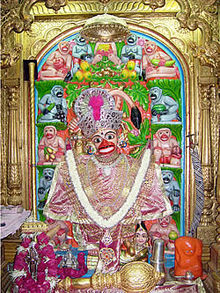 The Kashtbanjan Hanuman idol at Shri Hanuman Mandir, Sarangpur is one of the temple noted for getting rid of evil spirits.[34]
The Kashtbanjan Hanuman idol at Shri Hanuman Mandir, Sarangpur is one of the temple noted for getting rid of evil spirits.[34]
Suchindram temple is a pious place lying about 14 km from Kanyakumari, TamilNadu.The temple is famous for it 18 feet tall Hanuman idol. This idol is decorated fully with butter (Vennai kappu in Tamil) and Sandalwood paste (Chandana kappu in Tamil). This is being done by the devotees for fulfillment of their wishes. Further, garland prepared out of Vada is one of the offerings to the deity.
In Rajasthan,Hanuman Temples at Mehendipur in Dausa district (80 km from Jaipur) and Salasar dhaam in Churu district(160 km from Jaipur)attract a large number of devotees from allover India.
Kaviyur is a small village about 5–6 km from the town of Thiruvalla, Kerala The Shiva temple here is about 100 years old and The Hanuman temple inside the Shiva temple is considered as very auspicious by devotees. Hanuman idol consecrated here is made of Panchaloha and is depicting him telling the story of Ramayana to Sita in the Asoka Vana
Panchamukha Hanuman
Hanuman assumed Panchmukha or five-faced form to kill Ahiravana, a powerful rakshasa black-magician and practitioner of the dark arts during the Ramayana war. Ahiravana, brother of Ravana, had taken Lord Rama and Lakshmana to netherworld as captive, and the only way to kill him was to extinguish five lamps burning in different directions, all at the same instant. Hanuman assumed His Panchamukha form and accomplished the task, thus killing the rakshasa, and freeing Rama and Lakshmana.[24][26]
The five faces are of an eagle (garuda) - facing West, a boar (varaha) - facing North, a horse (hayagriva) - facing Up, a lion (narsimha) - facing South and one his own Hanuman - facing East.[24][26][35] The Panchamukha Hanuman has ten arms and holds as such ten weapons in each hand. The weapons are a parashu, a talwar, a chakra, a dhaal, a gada, a trishula, a kumbha, a Katar, a plate filled with blood and again a big Gada.
This also signifies that deity keeps vigilance and has control over the five directions - north, south, east, west and the upward direction/zenith.[24]
The face towards the East is Sri Hanuman is in its original form. This face removes all blemishes of sin and confers purity of mind.[35]
The South facing face of Narasimha, removes fear of enemies and confers victory.[35]
The West facing face of Garuda drives away evil spells, black magic influences, negative spirits and removes all poisonous effects in one's body.[35]
The North facing face of Varaha facing the North wards off the troubles caused by bad influences of the planets and confers all eight types prosperity (Ashta Aishwarya).[35]
The upwards facing (Urdhva Mukha) face of Hayagriva confers knowledge, victory, good wife and progeny.[35]
This form of Hanuman is very popular, and is also known as Panchamukha Anjaneya and Panchamukhi Anjaneya. (Anjaneya, which means "son of Anjana", is another name of Hanuman). One of the most famous places of Pilgrimage in central India is claimed to be the Resting Place of Shiri Hanuman Ji is Chitrakoot. The Hanuman Dhara Temple is situated on the peak of mountain where there is natural rock formation image of Shri Hanuman inside the cave and a natural stream of water falling on the tail. It is believed that after the coronation of Lord Ram, Hanuman requested for a permanent place to settle in the Kingdom of Lord Ram, where his Injury of burns on his tails will be cured. Lord Ram, then with his arrow, spurred a stream of water on the tip of mountain and asked Hanuman to rest there with water of the stream falling on his tail to cool down burning sensation in his tail.
The access to the cave temple is through stairs starting from bottom of the mountain to its top. It takes roughly 30 to 40 minutes to reach the temple. Over time the temple has gained a new name, namely Hanuman Dhara.
Sri Panchamukha Anjaneya Swami was the main deity of Sri Raghavendra Swami. The place where he meditated on this five-faced form of Hanuman is now known as Panchamukhi, wherein a temple for him has been built. There is also a shrine for Panchamukha Anjaneya Swami at Kumbakonam in Tamil Nadu, India. A 40 feet (12 m) tall monolithic green granite murti of Sri Panchamukha Hanuman has been installed in Thiruvallur, also in Tamil Nadu. This place was known as Rudravanam in olden times when many saints and seers had blessed this place with their presence. The Panchamukha Hanuman Ashram itself was established by a saint called Venkatesa Battar.
Relation with Shani (Saturn)
In Hinduism, Hanuman is the only God not afflicted by Shani.[36] Hanuman is the one of the deities in Hindu religion, over whom Shani could not cast his spell. Shani who spared Shiva, Vishnu and Brahma could not overcome Hanuman and as such people worship Hanuman to get rid of malefic effects of Shani.
In the Ramayana, Hanuman is said to have rescued Shani, from the clutches of Ravana.[37] In gratitude, Shani promised Hanuman that those who prayed him (Hanuman) would be rescued from the painful effects of Saturn, which in Hindu astrology, is said to produce malefic effects on one's life when one is afflicted "negatively" with Saturn.[37]
Another version of the encounter between Lord Hanuman and Shani Bhagavan is that the latter once climbed on to Lord Hanuman's shoulder, implying that he (Hanuman) was coming under the effects of the influence of Shani. At this, Hanuman assumed a large size, and Shani was caught painfully between Hanuman's shoulders and the ceiling of the room they were in. As the pain was unbearable, Shani requested Hanuman to release him, promising that he (Shani) would moderate the malefic effects of his influence on a person praying to Hanuman. Hanuman released Shani thereafter.[38]
In the verse with a thousand Names of Hanuman the Hanumansahasranam stotra, Shani is one of the Names of Hanuman.[24] In some regions of India, Hanuman is also seen sporting an iron whip akin to Shani.[24]
Hanuman and negative energies
Hanuman is worshiped also to get rid or win over demons ( like daity, danav), demi-gods ( like Yaksha, kinnara, Gandharvas, Nāga-Nāginī ) , evil spirits ( like Bhut, Pret, Pishacha, Churel, Vetal, Brahmrakshas ) and negative energies ( like Dakini, Shakini, Kakini, Kamini )[39] Besides there are many other Hanuman matras to win over or destroy these spirits.[40][41] among which famous ones are Panchamukhi Hanuman Kawacham[42] and Saptamukhi Hanuman Kawacha[43]
Hanuman Suvarchala
Though generally portrayed as a bachelor, some believe that Hanuman married Suvarchala, Surya's daughter.[44]
List of some Hanuman Mantras
There are many prayers, songs, mantras, shlokas, kavach, paaths devoted to Hanuman in Hindu scripts, to get rid of above named evil spirits and also sickness, illness and other problems of life.. Names of some famous Hanuman prayers are :-
- Hanuman Chalisa[25]
- Bajrang Baan[45]
- Maruti Strotam[39]
- Valvanal Strotam[46]
- Hanuman Sathhika[47]
- Hanuman Bahuk[48]
- Hanuman Dwadesh
- Ek-mukhi Hanuman Raksha Kavacham[49]
- Panch-mukhi Hanuman Raksha Kavacham[42]
- Sapta-mukhi Hanuman Raksha Kavacham[43]
- Bhimrupi Strotam[50]
- Sundarkand
- Maruti Gayatri Mantra[24]
- Hanumansahasranam stotra - Stotra of thousand names of Hanuman.[24]
- Hanuman Bisa.
Even Ram Raksha Strotam, the Sanskrit Strota, a Shield of Rama has lines devoted to Hanuman, saying, whoever, reads this, will be protected by Hanuman.
See also
- Hanuman temples
- Hanuman Chalisa
- Hanuman Jayanti
- Kesari
- Shri Madhvacharya
- Sun Wukong - a popular classical Chinese fictional character known as the Monkey King
Notes
- ^ Orlando O. Espín, James B. Nickoloff An introductory dictionary of theology and religious studies. 2007, page 537
- ^ Rosen, Steven. Essential Hinduism. 2006, page 67-8
- ^ Gumla block, Official website of the Gumla District
- ^ Ali Javid, Tabassum Javeed, ed (2008). World heritage monuments and related edifices in India, Volume 1. Algora Publishing. p. 247. ISBN 9780875864822.
- ^ Harish Kapadia (2008). Trek the Sahyadris. Indus. p. 18. ISBN 9788173871511.
- ^ Sri Ramakrishna Math (1985) "Hanuman Chalisa" p. 5
- ^ Sri Ramakrishna Math (1985) "Hanuman Chalisa" pp. 5-6
- ^ Sri Ramakrishna Math (1985) "Hanuman Chalisa" p. 6
- ^ Sri Ramakrishna Math (1985) "Hanuman Chalisa" p. 7
- ^ [1]
- ^ [2]
- ^ [3]
- ^ Sri Ramakrishna Math (1985) "Hanuman Chalisa" p. 7
- ^ a b Sri Ramakrishna Math (1985) "Hanuman Chalisa" p. 8
- ^ [4]
- ^ Goldman, Robert P. (Introduction, translation and annotation) (1996). The Ramayana of Valmiki: An Epic of Ancient India, Volume V: Sundarakanda. Princeton University Press, New Jersey. 0691066620. pp. 45-47.
- ^ a b Lutgendorf, Philip. Hanuman's tale: the messages of a divine monkey. 2007, page 147
- ^ a b Sri Ramakrishna Math (1985) "Hanuman Chalisa" p. 9
- ^ [5]
- ^ [6]
- ^ [7]
- ^ Kehari Vahan soh Bhavani, Langur Veer Chalat agavani !! Kar men khappar khadag viraje, Jako dekh kal dan bhaje !!
- ^ Reposing gracefully uopn your vehicle, O Goddess Bhavani, You are welcome by the brave Langour (Lord Hanuman). When You appear in the form of Goddess Kali, with sword in one hand and a cupel in the other, Even Time flees in panic.
- ^ a b c d e f g h [8]
- ^ a b HANUMAN CHALISA Mother Janaki has blessed you with the power to bestow on your devotees eight Siddhis and Nine Nidhis
- ^ a b c d [9]
- ^ According to this site, http://www.kakaji.org/shikshapatri_verses.asp?catid=viewAll, verses 85, of their scripture, Shikshapatri, [10] states, "And if disturbance from ghostly spirits is ever experienced, chant the Narayankavach or Hanuman's mantra, but one should not chant the stotra or mantra of any low deity."
- ^ Hanuman, Hindupedia, the Hindu Encyclopedia
- ^ Claus (2003)
- ^ The Indian Express, Chandigarh, Tuesday, November 2, 2010, p. 5.
- ^ Reports of a Tour in Bundelkhand and Rewa in 1883-84, and of a Tour in Rewa, Bundelkhand, Malwa, and Gwalior, in 1884-85, Alexander Cunningham, 1885
- ^ Hanuman's tale: the messages of a divine monkey, Philip Lutgendorf, Oxford University Press US, 2007
- ^ Hanuman's tale: the messages of a divine monkey, Philip Lutgendorf, 2007
- ^ a b Raymond Brady Williams (2001). An introduction to Swaminarayan Hinduism. Cambridge University Press. ISBN 9780521654227. http://books.google.co.uk/books?id=tPkexi2EhAIC&pg=PA128&dq=hanuman+sarangpur#PPA128,M1. Retrieved May 14, 2009. Page 128
- ^ a b c d e f Panchamukha Hanuman
- ^ [11] according to scriptures Shani declared that any one who worshipped Lord Hanuman would not be affected by the evil effect of the planet-Source-spirituality.indiatimes.com
- ^ a b Lutgendorf, Philip (2007). Hanuman's tale: the messages of a divine monkey. Oxford University Press US. p. 141. ISBN 9780195309218. http://books.google.co.in/books?id=fVFC2Nx-LP8C&pg=PT333&dq=avatara+Hanuman&cd=1#v=snippet&q=avatara%20%20Shiva&f=false.
- ^ [12] Shani & Hanuman-Source Google Books-Gods and goddesses of India By Kailash Nath Seth, B. K. Chaturvedi
- ^ a b Vichitra veer hanuman mantra-Maruti stotram ...prakat vikram veer daity danav yaksha graha bandhnay bhut graha bandhanay pret grah bandhnay pishach grah bandhnaye shakini dakini graha bandhay kakini kamini graha bandhnay braham graha bandhnay brahmrakshas graha bandhnay...
- ^ ...hanumanji kaval, kunda, hathi, khappar, chadi, masan, guggal dhoop jap tera, tera roop shakini bandhu, dakini bandhu, atal ko bandhu, paatal tekri ko bandhu, hanumanji ke rochna ko bandhu..
- ^ Lord Hanuman is the God of velour power, wisdom and great renown. The devotees believe that Hanuman dispels all fears and all spirits. All ailments caused by Ghosts, spirits, Goblins, Ghouls, Malignant, super natural powers such as Shakini, Dakini, Pishachini etc. Therefore, they propitiate the Lord for their own protection and the protection of their family.
- ^ a b Panchamukhi Hanuman Kavacham
- ^ a b Saptamukhi Hanuman Kavacham and many others.
- ^ [13]
- ^ ...Bhoota prayta pishacha nischaara, Agni Baitala kaal maari mar..
- ^ Vadavanal Strota
- ^ Hanuman Sathika
- ^ Hanuman Bahuk
- ^ Veera Hanuman Kavacham
- ^ Bhimrupi Maharudra (Hanuman Stotra)
References
- Claus, Peter J.; Sarah Diamond, Margaret Ann Mills (2003). "Hanuman". South Asian folklore. Taylor & Francis. pp. 280–281. ISBN 9780415939195. http://books.google.com/books?id=au_Vk2VYyrkC&pg=PA280.
- Lutgendorf, Philip (2007). Hanuman's tale: the messages of a divine monkey. Oxford University Press US. pp. 434. ISBN 9780195309218. http://books.google.com/books?id=fVFC2Nx-LP8C&printsec=frontcover.
- Sri Ramakrishna Math (1985): Hanuman Chalisa. Chennai (India): Sri Ramakrishna Math. ISBN 81-7120-086-9.
- Mahabharata (1992). Gorakhpur (India): Gitapress.
- Anand Ramayan (1999). Bareily (India): Rashtriya Sanskriti Sansthan.
- Swami Satyananda Sarawati: Hanuman Puja. India: Devi Mandir. ISBN 1-887472-91-6.
- The Ramayana Smt. Kamala Subramaniam. Published by Bharatiya Vidya Bhavan (1995). ISBN 8172764065
- Hanuman - In Art, Culture, Thought and Literature by Shanti Lal Nagar (1995). ISBN 81-7076-075-5
Further reading
- Vanamali, Mataji Devi (2010). Hanuman: The Devotion and Power of the Monkey God Inner Traditions, USA. ISBN 1594773378.
External links
Ramayana by Valmiki Ikshvaku clan Dasharatha · Kausalya · Sumitra · Kaikeyi · Rama · Bharata · Lakshmana · Shatrughna · Sita · Urmila · Mandavi · Shrutakirti · Lava · KushaVanara Rakshasa Ravana · Vibhishana · Kumbhakarna · Indrajit · Akshayakumara · Atikaya · Kabandha · Khara · Mandodari · Maricha · Mayasura · Prahasta · Subahu · Sulochana · Sumali · Surpanakha · Tataka · ViradhaSages Other characters Places Other Hindu deities and texts Gods 
Goddesses Texts Hinduism · Hindu mythology · Indian epic poetry Categories:- Hindu gods
- Animal gods
- Chiranjivins
- Vanara in the Ramayana
- Sanskrit words and phrases
Wikimedia Foundation. 2010.

